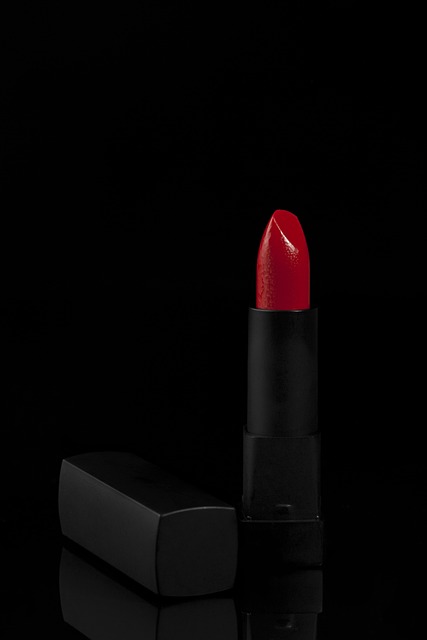Red lipstick is a sophisticated makeup staple enriched with pigments like iron oxides for a range of red shades, emollients for comfort and moisture, and protective agents to ensure longevity and safety on the lips. It's composed of waxes such as carnauba or beeswax for smooth application, moisturizing oils including castor seed oil, shea butter, and vitamin E to maintain lip health, and emollients like dimethicone to protect against environmental factors. Some formulations include UV-protective agents to shield against harmful UV rays. Red lipstick can be both synthetic, with fade-resistant pigments like Red 7 Lake for bold color, and natural, sourced from ingredients like beetroot or cranberry extracts for a more subtle shade range. Consumers are encouraged to consider the U.S. Food and Drug Administration's (FDA) role in regulating safety standards for these products, ensuring that all pigments, including lake chemicals, are approved and that heavy metal levels like lead and arsenic are within safe limits. It's crucial for consumers to read labels carefully, selecting red lipsticks that adhere to FDA regulations for a safe and radiant application.
exploration into the constituents of red lipstick reveals a blend of pigments, emollients, and preservatives, each serving distinct purposes for color, texture, and shelf-life. This article dissects the chemical makeup of this iconic cosmetic item, contrasting synthetic and natural variations, and scrutinizes safety and regulatory frameworks governing its ingredients. Red lipstick’s enduring presence in beauty routines prompts a closer examination of its chemical composition and the implications for consumers’ health and choices.
- Unveiling the Chemical Composition of Red Lipstick: Ingredients and Their Roles
- Synthetic vs Natural Red Lipsticks: Understanding the Differences in Chemistry
- The Safety and Regulation of Chemicals in Red Lipstick: What Consumers Need to Know
Unveiling the Chemical Composition of Red Lipstick: Ingredients and Their Roles

Red lipstick, a staple in many makeup kits, is a complex blend of pigments, emollients, and various other ingredients that contribute to its texture, color, and staying power. The primary pigment responsible for the crimson hue in red lipsticks is typically iron oxides, which provide a wide range of shades from deep burgundy to bright scarlet. These pigments are safe and commonly used in cosmetics, as well as in other industries like food coloring and paint. Alongside these pigments, red lipstick contains waxes such as carnauba or beeswax, which form the base structure of the product, ensuring it has a smooth and consistent texture upon application. These waxes also facilitate the glide of the lipstick across the skin, providing a comfortable and long-lasting wear.
In addition to the pigments and waxes, red lipsticks are often enriched with moisturizing oils like castor seed oil, shea butter, or vitamin E. These ingredients play a crucial role in nourishing the lips, preventing dryness, and improving the overall health of the lip area. Emollients such as dimethicone and silicones may be included to create a barrier on the skin, which helps to lock in moisture and protect the lips from environmental factors. Additionally, red lipstick may contain sunscreen agents like octinoxate or avobenzone, which offer some level of protection against ultraviolet (UV) radiation, further enhancing the care properties of the product. The careful selection and precise ratio of these components ensure that red lipstick not only makes a bold fashion statement but also maintains the lips’ health and appearance.
Synthetic vs Natural Red Lipsticks: Understanding the Differences in Chemistry

Red lipstick, a timeless beauty staple, comes in two primary forms: synthetic and natural. The chemistry behind these lipstick types differs significantly, influencing their color, longevity, and safety profiles. Synthetic red lipsticks are formulated with pigments produced through industrial chemical processes. These pigments, such as Red 7 Lake or Red 6 Lake, offer a consistent, vibrant hue that is often resistant to fading. The manufacturing of synthetic red lipsticks ensures a uniform application and durability throughout wear. On the other hand, natural red lipsticks are crafted using pigments derived from natural sources like beetroot or cranberry extracts. These pigments provide a more nuanced shade with variations that can mimic the subtleties of red found in nature. The chemical composition of natural red lipsticks typically includes fewer synthetic additives, which can appeal to consumers who prefer cosmetic products with minimal artificial ingredients. Both options have their merits and are favored for different reasons, with consumer preference largely dictating the choice between synthetic and natural red lipstick. Understanding the differences in their chemistry allows consumers to make informed decisions based on personal values and beauty needs.
The Safety and Regulation of Chemicals in Red Lipstick: What Consumers Need to Know

When selecting a red lipstick, consumers should be aware of the safety and regulatory standards that govern the chemicals used in these cosmetics. The United States Food and Drug Administration (FDA) oversees the color additives in cosmetics like lipstick, ensuring that they are safe for use. These regulations mandate that any chemical used must be listed on the product label, allowing consumers to make informed choices based on personal preferences or sensitivities. Lake chemicals, which are water-soluble dyes, are commonly used in red lipsticks to achieve a vibrant hue. The FDA has a specific list of approved lake pigments that can be used in cosmetics, guaranteeing their safety.
Furthermore, the FDA also sets limits on heavy metals such as lead and arsenic, which can naturally occur in color pigments. While trace amounts may be found due to natural occurrence or contamination, these levels are regulated to minimize health risks. It’s important for consumers to note that within the scope of red lipstick use, the concentrations of metals typically fall well below levels of concern as per FDA standards. Additionally, manufacturers are prohibited from using color additives that are unsafe under the conditions of use prescribed in the regulations or which are adulterated with impurities. By being vigilant and reading labels carefully, consumers can select red lipsticks that align with their safety expectations and regulatory compliance, ensuring a beautiful and safe application.
In summary, the chemical composition of red lipstick encompasses a spectrum of ingredients, each fulfilling distinct roles for color, texture, and longevity. The distinction between synthetic and natural red lipsticks is significant, with natural variants often containing fewer synthetic chemicals, yet both types are regulated to ensure safety. Consumers must be informed about the regulatory standards that govern the substances allowed in their cosmetics, particularly red lipstick. By understanding these aspects, individuals can make educated decisions that align with their personal preferences and health considerations regarding lipstick use. Red lipstick remains a timeless beauty staple, and with the right knowledge, it can be both vibrant and safe for everyday application.
